
A mortar is usually a simple, lightweight, man-portable, muzzle-loaded weapon, consisting of a smooth-bore metal tube fixed to a base plate with a lightweight bipod mount and a sight. They launch explosive shells in high-arcing ballistic trajectories. Mortars are typically used as indirect fire weapons for close fire support with a variety of ammunition.

A shell, in a military context, is a projectile whose payload contains an explosive, incendiary, or other chemical filling. Originally it was called a bombshell, but "shell" has come to be unambiguous in a military context. Modern usage sometimes includes large solid kinetic projectiles, which are more properly termed shot. Solid shot may contain a pyrotechnic compound if a tracer or spotting charge is used.

"Mills bomb" is the popular name for a series of British hand grenades which were designed by William Mills. They were the first modern fragmentation grenades used by the British Army and saw widespread use in the First and Second World Wars.

The Grenade, Hand, No. 1 was the first British hand grenade used in World War I. It was designed in the Royal Laboratory, based on reports and samples of Japanese hand grenades during the Russo-Japanese War provided by General Sir Aylmer Haldane, who was a British observer of that war.

The Type 89 grenade discharger, inaccurately and colloquially known as a knee mortar by Allied forces, is a Japanese grenade launcher or light mortar that was widely used in the Pacific Theater of World War II. It got the nickname the "knee mortar" because of an erroneous Allied belief that these launchers could be fired by propping its plate against the leg. However, anyone trying to fire it this way would receive a severe bruise from its hefty recoil.

The Ordnance SBML two-inch mortar, or more commonly, just "two-inch mortar", was a British mortar issued to the British Army and the Commonwealth armies, that saw use during the Second World War and later.
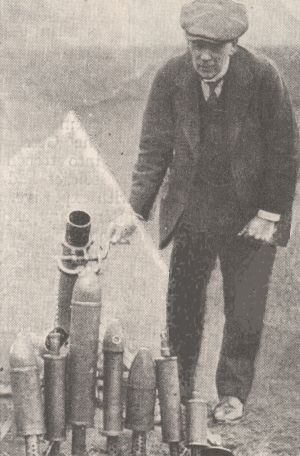
The Stokes mortar was a British trench mortar designed by Sir Wilfred Stokes KBE that was issued to the British and U.S. armies, as well as the Portuguese Expeditionary Corps, during the latter half of the First World War. The 3-inch trench mortar is a smooth-bore, muzzle-loading weapon for high angles of fire. Although it is called a 3-inch mortar, its bore is actually 3.2 inches or 81 mm.

The Newton 6-inch mortar was the standard British medium mortar in World War I from early 1917 onwards.
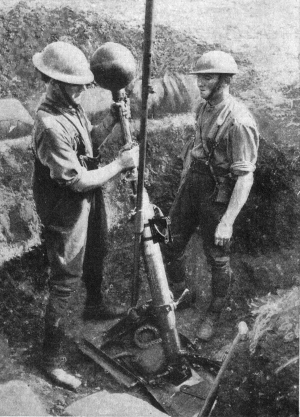
The 2 inch medium trench mortar, also known as the 2-inch howitzer, and nicknamed the "toffee apple" or "plum pudding" mortar, was a British smooth bore muzzle loading (SBML) medium trench mortar in use in World War I from mid-1915 to mid-1917. The designation "2-inch" refers to the mortar barrel, into which only the 22-inch bomb shaft but not the bomb itself was inserted; the spherical bomb itself was actually 9 inches (230 mm) in diameter and weighed 42 lb (19 kg), hence this weapon is more comparable to a standard mortar of approximately 5-6 inch bore.

The HG 85 is a round fragmentation hand grenade designed for the Swiss Armed Forces and still produced by RUAG Ammotec in Switzerland. HG 85 is the internal designation of the Swiss Army and replaces the HG 43 from WWII.
In military munitions, a fuze is the part of the device that initiates function. In some applications, such as torpedoes, a fuze may be identified by function as the exploder. The relative complexity of even the earliest fuze designs can be seen in cutaway diagrams.

A grenade is an explosive weapon typically thrown by hand, but can also refer to a shell shot from the muzzle of a rifle or a grenade launcher. A modern hand grenade generally consists of an explosive charge ("filler"), a detonator mechanism, an internal striker to trigger the detonator, and a safety lever secured by a cotter pin. The user removes the safety pin before throwing, and once the grenade leaves the hand the safety lever gets released, allowing the striker to trigger a primer that ignites a fuze, which burns down to the detonator and explodes the main charge.
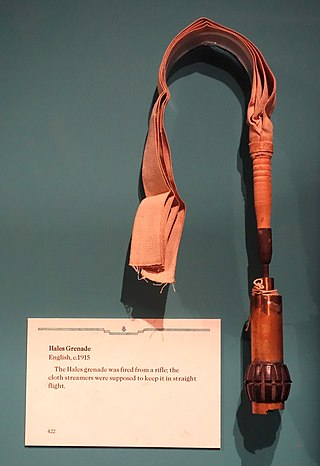
The Hales rifle grenade is the name for several rifle grenades used by British forces during World War I. All of these are based on the No. 3 design.

An artillery fuze or fuse is the type of munition fuze used with artillery munitions, typically projectiles fired by guns, howitzers and mortars. A fuze is a device that initiates an explosive function in a munition, most commonly causing it to detonate or release its contents, when its activation conditions are met. This action typically occurs a preset time after firing, or on physical contact with or detected proximity to the ground, a structure or other target. Fuze, a variant of fuse, is the official NATO spelling.

The number 106 fuze was the first British instantaneous percussion artillery fuze, first tested in action in late 1916 and deployed in volume in early 1917.
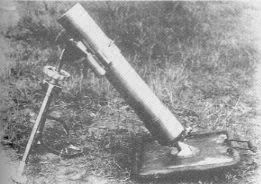
The Type 99 81 mm mortar was a Japanese mortar used primary by Imperial Japanese Army during World War II. The Type 99 designation was given to this mortar as it was accepted in the year 2599 of the Japanese calendar (1939). The Type 99 81 mm mortar is typical of the Stokes-Brandt type mortar. The Type 99 81 mm mortar differs from the Type 97 81 mm infantry mortar in the shortness of its tube and in the method of firing. The differences between the Type 99 and the US 81-mm mortar, M1 are pronounced.
The Type 3 81 mm mortar is a smooth bore, muzzle-loading 81 mm (3.19 in) infantry weapon used by the Imperial Japanese Army during World War II. The Type 3 designation was given to this gun as it was accepted in the 3rd year of Emperor Taishō's reign (1914).

Major Herbert Garland OBE MC FCS M. Inst. Metals was a British metallurgist and army officer. An Army Ordnance Corps member, in 1906 he was stationed on Guernsey, where he wrote a novel, Diverse Affections: a Romance of Guernsey. Garland rose to become Superintendent of Laboratories at the Cairo Citadel, Egypt by 1913 and received a grant from the Chemical Society, of which he was a fellow, to conduct research into ancient Egyptian alloys. The outbreak of war saw him commissioned as a Special List officer with the Arab Bureau. Garland developed explosives for the army, including the Garland grenade and was, in September 1916, assigned to train T. E. Lawrence and the fighters of the Arab Revolt in explosives. His mines were used against the Hejaz Railway and may have been involved in the first derailing of a moving train by explosives. Garland commanded the desperate defence of Yanbu in which he forced an attacking superior Ottoman force to withdraw with almost no bloodshed. Awarded the Military Cross and appointed an Officer of the Order of the British Empire, Garland became director of the Arab Bureau after the war and was involved in the post-war negotiations for the future of Arabia. Returning from Egypt because of poor health, Garland died within days of setting foot in England.

The Garland trench mortar was an improvised mortar used by Australian and British forces at Gallipoli during the Dardanelles Campaign of 1915–16. Developed early in the war by Herbert Garland, a pre-war metallurgist and superintendent of laboratories at the Cairo Citadel, it was the most numerous mortar of the Gallipoli Campaign. A simple, improvised design, the Garland mortar consisted of a smoothbore steel barrel fixed at 45 degrees to a solid wooden base. By means of a powder charge it propelled a variant of the jam tin grenade. Its design meant that the whole weapon had to be turned to change its traverse and raised on a box to increase its range but despite these limitations it was reported to have done "good work" in the front line.
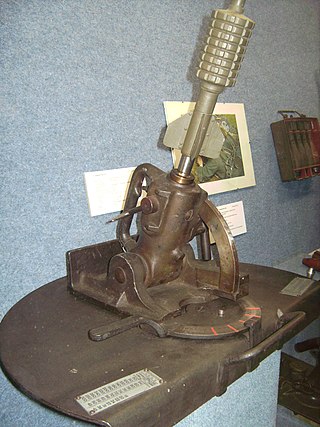
The kleineGranatenwerfer 16 or Gr.W.16(Small Grenade Launcher Model 1916) in English, was an infantry mortar used by the Central Powers during the First World War. It was designed by a Hungarian priest named Father Vécer and was first used by the Austro-Hungarian Army in 1915. In Austro-Hungarian service, they received the nickname "Priesterwerfers". In 1916 Germany began producing a modified version under license for the Imperial German Army.


















